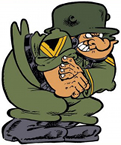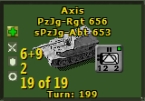samba_liten
Posts: 367
Joined: 8/31/2001
From: Currently in Kiev
Status: offline

|
Some more. Not as detailed as one would wish perhaps, but a start.
quote:
War Structure of Infantry Division 43
Division staff with map unit including printing troop (motorized), traffic
control platoon (motorized) and music corps.
3 Grenadier Regiments, each with:
1 staff company with intelligence platoon, engineer platoon, mounted
or bicycle platoon (6 light machine guns in all).
1 staff company with staff, 3 grenadier companies each (each with 16
light machine guns, 2 81mm medium grenade launchers) and 1 heavy
company (12 heavy machine guns, 6 81mm medium grenade launchers
or 75mm light infantry guns).
1 infantry gun company (12 81mm medium grenade launchers, 4
120mm heavy grenade launchers or 150mm heavy antitank guns).
1 antitank company (1 platoon with close-combat weapons, 1 platoon
with 50mm medium antitank guns, 1 platoon with 75mm heavy antitank
guns motorized).
1 fusilier battalion (instead of reconnaissance unit) with staff, structured
like a grenadier battalion, but with one company equipped with
bicycles and therefore capable of being used for reconnaissance.
1 Panzerjäger unit with staff, 1st company (6 37mm light antitank
guns, 6 50mm medium antitank guns), 2nd company (12 75mm heavy
antitank guns motorized), 3rd company (12 20mm light anti-aircraft guns
on self-propelled mantelets).
1 Artillery Regiment with:
Staff and staff battery
2 light units (each with staff, staff battery and 3 batteries, each with 4
105mm light howitzers, horsedrawn).
1 heavy unit (staff, staff battery and 3 batteries, each with 4 150mm
heavy howitzers motorized) (sometimes also 1 unit with 2 batteries of
88mm anti-aircraft guns, motorized for ground combat).
1 engineer battalion with staff, 1 horsedrawn company, 1 company
with bicycles, battle gear echelon.
1 intelligence unit with staff, 1 telephone company, partly motorized,
1 radio company, motorized, 1 light intelligence column.
1 division combat school.
Medical Services with:
1 medical company, horsedrawn
1 medical company, motorized
1 ambulance company
Administrative Services with:
1 administrative company, motorized, including commissariat
1 bakery company, motorized
1 butcher company, motorized
1 veterinary company, horsedrawn
1 field post office, motorized
Supply Services with:
Staff division supply leader (Dinafü)
2 wagon columns, horsedrawn, with total potential load of 90 tons
1 truck company with potential load of 30 tons
1 supply company, partly motorized
1 motor park troop company with 2 repair-shop platoons and 1 armorer
platoon
Noteworthy differences between this new structure and the old type are:
The 3rd battalion of every regiment was disbanded, likewise the regimental
band and the light infantry columns, the supply trains were
strongly reduced. The reconnaissance unit was turned into a fusilier battalion,
corresponding to a grenadier battalion, the Panzerjäger unit was
armed with fewer antitank guns. The artillery regiment lost its third light
unit and horsedrawn column, and the engineer battalion was also
strongly reduced. The field replacement battalion was also cut. In the
medical services, the field hospital had been largely eliminated since 1942
and transferred to the army medical units. But field hospitals could be
requested in cases of special need. In addition, the supply services were
reduced.
At first glance, the reductions in supply trains and services do not
appear very great. But the decisive feature was that a large number of
these soldiers could now be replaced by volunteers who were now an
144 THE GERMAN INFANTRY HANDBOOK 1939-1945
organized part of the army (see also section "The Volunteers") and added
to the combat troops.
These new-type divisions were supposed to have, as of December 1,
1943, a total strength of 13,656 men, of whom 9652 men (71.6%) belonged
to the combat groups, 2245 men (16.4%) to the supply trains and 1759
men (12%) to the back-line services. In the supply and back-line services,
several hundred volunteers (the number was not officially set, but left up
to the division) often worked.
The armaments were: 2128 pistols, 7980 rifles, 103 rifles with telescopic
sights, 302 grenade-launching rifles (Schiessbecher), 681 machine
pistols, 128 light and heavy machine guns, 72 81mm medium grenade
launchers, 21 120mm heavy grenade launchers, 12 75mm light infantry
guns, 6 150mm heavy infantry guns, 6 37mm light antitank guns, 24
50mm medium antitank guns, 18 75mm heavy antitank guns, 12 20mm
light anti-aircraft guns, 24 105mm light howitzers, 12 150mm heavy howitzers.
Later there were also 600 assault rifles, 108 Panzerschreck and a
great number of Panzerfaust antitank weapons.
_____________________________
السلام عليكم
|
 Printable Version
Printable Version









 :
: 











 New Messages
New Messages No New Messages
No New Messages Hot Topic w/ New Messages
Hot Topic w/ New Messages Hot Topic w/o New Messages
Hot Topic w/o New Messages Locked w/ New Messages
Locked w/ New Messages Locked w/o New Messages
Locked w/o New Messages Post New Thread
Post New Thread